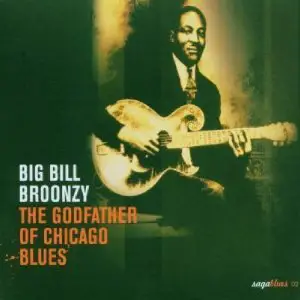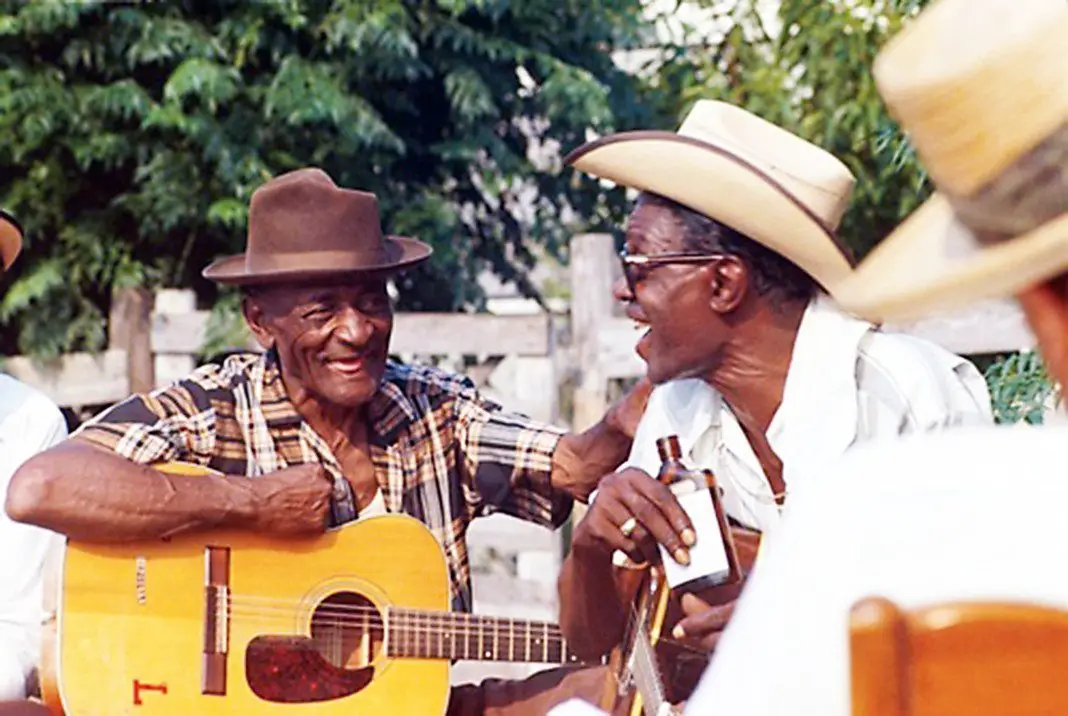Who is the original singer of "Baby, Please Don't Go"?
The original singer of "Baby, Please Don't Go" was Big Joe Williams, a Delta blues musician. He first recorded the song on October 31, 1935, in Chicago for Bluebird Records with his group credited as Joe Williams' Washboard Blues Singers.
Williams' recording popularized the traditional blues song, which has since become a blues standard and has been covered by numerous artists across various genres.
Acoustic Blues Guitar Video Lesson Preview - Baby Please Don't Go by Lightnin' Hopkins
Among Big Joe Williams and Muddy Waters most popular songs
Of course, this song has been recorded before by many people, like Big Joe Williams. Big Joe has a great voice but his guitar work doesn’t have the power and depth of Lightnin’s sound. His rhythmic style and sure touch gives his music a special feeling that is tough to imitate.
 It isn’t
technically difficult, although the timing is interesting in places, but the
overall effect of Lightnin’s deep Texas drawl and his finger picking technique
is a powerful combination that touches his listeners. BB King once said that
Elvis had a special characteristic – when he sang, you just believed him – you
couldn’t help, there is a sincerity in the voice that can’t be manufactured or
pretended. Lightnin’ is like that – he sings a story and we just believe him.
It isn’t
technically difficult, although the timing is interesting in places, but the
overall effect of Lightnin’s deep Texas drawl and his finger picking technique
is a powerful combination that touches his listeners. BB King once said that
Elvis had a special characteristic – when he sang, you just believed him – you
couldn’t help, there is a sincerity in the voice that can’t be manufactured or
pretended. Lightnin’ is like that – he sings a story and we just believe him.
He used a plastic thumb pick and mostly one finger for his picking, which sometimes strummed several strings up the neck to give a light and warm sound. Many of his songs were thinly disguised copied of standard blues, and although he is credited with more than a hundred original pieces and songs, many of these are very, very similar to each other. Still, his output and style were legendary and he remains an incredibly important blues guitar player to this day.
Played in
the key of E, the monotonic thumb bass is adapted to this slightly up tempo
song as he stamps his own style on the blues. In one place he stops to take an
instrumental break and shows how he has complete control of his thumb, striking
on the off-beat while alternating with his index picking finger to produce a
syncopated sound that is difficult to produce with the same kind of effect –
it’s so sure and the timing is perfect.
 His thumb
would strike the bass string twice and then again after his index finger has
counterpointed the sound with a treble note – powerful stuff.
His thumb
would strike the bass string twice and then again after his index finger has
counterpointed the sound with a treble note – powerful stuff.
As always (or
almost!) Lightnin’ doubles up on his solid thumb bass pattern to make the sound
of a heart beating, which is a powerful call to the emotions of the listener,
by-passing any intellectual viewpoint and going direct to the nitty-gritty! Big Bill Broonzy also does this.
Lightnin’ had a low, low voice and I get the impression that he sometimes tuned his guitar down a step or two, depending on the time of his life. Mind you, this rule is not hard and fast, as I know that on at least one video, he is tuned up one step, so I guess he decided when he wanted to do it depending on the song and the guitar.
Lightnin' might Change a Chord at Any Time!
We often find that Lightnin Hopkins changes chords in some strange places that don’t seem to make any sense, if we are firmly set on playing a blues with a fixed number of bars for example. He would bend the musical structure of the song around to suit his singing and the story he’s telling. If he need more time to add a line of verse, he’d just take it! It was probably tough to jam or accompany Hopkins on the guitar, as it was sometimes hard to know when to change chords.
Two Texas Blues Guitar Players - Lightnin' Hopkins and Mance Lipscombe, Strumming buddies

Here's my take on "Baby Please Don't Go," a famous song that's been a staple in my guitar lessons. Originally recorded by Big Joe Williams in 1935, it's become one of the most popular blues standards. The song's roots go deep, with connections to older folk themes.
I love teaching this song in my video lesson because it's so versatile. You can play it with simple strumming patterns or complex fingerpicking. The basic chords are straightforward - typically C, F, and G - but you can spice it up with variations like Cₘ or Em. Some versions even incorporate more complex chords chords like GB.
Many artists have covered it, from Muddy Waters to AC/DC. Each rendition brings something new to the tab, showing how flexible blues can be. In my lessons, we explore different ways to play the song on acoustic guitar, focusing on both rhythm and lead parts.
For those starting out, I've got free chords and tabs in my chord library. More advanced players might enjoy diving into the nuanced note choices in various solos. Whatever your level, this song is a great way to improve your blues chords (add 4), timing, and feel.
Don't forget to check out the reviews guitar of my courses if you're keen to learn more. Whether you're into strumming or intricate fingerstyle, "Baby Please Don't Go" is a fantastic song to add to your repertoire. It's one of those chords popular tunes that every guitarist should know how to play guitar.
What Chords Did The Texas Bluesmen Use?
Lightnin' Hopkins Popular Songs - The top ten
1 Mojo Hand2 Baby, Please Don't Go3 Bring Me My Shotgun4 Jail House Blues5 Short Haired Woman6 Sometimes She Will7 Lightnin's Boogie8 Coffee House Blues9 Have You Ever Loved A Woman10 Coffee BluesAuthor: Jim BruceDate: 2013-10-01Category: Music
baby-please-dont-go-lightin-hopkins.mp3
The Blues According To Lightnin' Hopkins
A visit to Houston for any fan of vintage black American music can’t fail to take in a ride through the city’s Third Ward, the cradle of South Texas blues and the point of origin for just about every strand of music to come out of H-Town since the early 20th century.
The look of the place has changed greatly from those days in the 1930s and 40s when it was the epicentre of black music activity in Houston and probably the whole of the American South.
It’s still the heartbeat of the city’s black community, but on streets where once great blues singers stood on corners and played for nickels and dimes, a profusion of coffee houses and smart restaurants for vegans and carnivores alike now stand.
A titan of Texas blues such as Sam John “Lightnin’” Hopkins would struggle to recognise Dowling Street as the place where he and his distant cousin Alger “Texas” Alexander plied their musical trade in the hope of making enough money to eat in the late 1930s, or where Lightnin’ was discovered in the mid-40s by Lola Ann Cullum, the well-to-do dentist’s wife with a passion for the blues and good contacts with Los Angeles’ Aladdin Records, his first recording home.
But at least Dowling Street hasn’t been bulldozed in the name of gentrification. If you wish to do so, it’s still possible to stand on a corner, close your eyes and imagine what it would have been like to hear Lightnin’ and his peers more than 65 years ago.
When I first started listening to blues records in the mid-60s, I was drawn to Lightnin’s music immediately. I loved his laconic vocal style and the relentless rhythmic thrust of his up-tempo sides.
I played his fantastic live recording of ‘Cadillac Blues’ over and over again, trying to decipher what he was saying in its opening rap in his often hard-to-decipher South Texas drawl, all the while waiting for him to drop the killer boogie riffs that come along half way through.
Once I discovered his R&B classic ‘Mojo Hand’ on a Sue compilation in 1964, I knew my ears would have a lifelong relationship with the music of Lightnin’ Hopkins. And they have.
Lightnin’ died aged 69 in 1982, leaving behind a remarkable recorded legacy that spanned more than 30 years. During the late 50s and early 60s, he was at his most prolific, recording for anyone who would offer a fee and selling many albums to folk-blues fans.
He made many fine albums during these years, some of the best of which have long been available on Ace. His earliest sides for labels such as Aladdin, Gold Star, Sittin’ In With and Modern capture him at his most essential.
Ace also have that period of his career covered with “Jake Head Boogie” (a collection of the finest Lightnin’ masters and alternate takes from the Modern Records inventory) and “His Blues”, a 2CD career overview issued in conjunction with Alan Govenar’s definitive Lightnin’ Hopkins biography of the same title.
Unlike many of his Houston contemporaries, Lightnin’ enjoyed worldwide fame and acknowledgement of his contributions toSouth Texasblues while he was still alive. It’s a fitting testament to his talents that he has so many CDs available more than 30 years after his death. To find the man and his music at their very best, you need look no further than Ace.
Article Source: https://www.acerecords.co.uk/lightnin-hopkins
Baby, Please Don't Go: FAQ
Who originally did "Baby, Please Don't Go"?
The song "Baby, Please Don't Go" was originally recorded by Delta blues musician Big Joe Williams in 1935. He recorded it with his group credited as Joe Williams' Washboard Blues Singers.
Did the Animals sing "Baby, Please Don't Go"?
The Animals did not record "Baby, Please Don't Go." You might be thinking of Them, the Northern Irish band fronted by Van Morrison, who recorded a popular version of the song in 1964.
Who is the original singer of "Please Don't Go"?
The original singer of "Baby, Please Don't Go" was Big Joe Williams. He first recorded the song on October 31, 1935, in Chicago for Bluebird Records.
Who played guitar on "Baby Please Don't Go" by Them?
There is some controversy about who played guitar on Them's version of "Baby Please Don't Go." While Billy Harrison was the group's regular guitarist, there are claims that Jimmy Page, then a studio musician, may have played on the recording. Some sources suggest Page might have played rhythm guitar or doubled a bass riff, but his exact contribution remains unclear.

